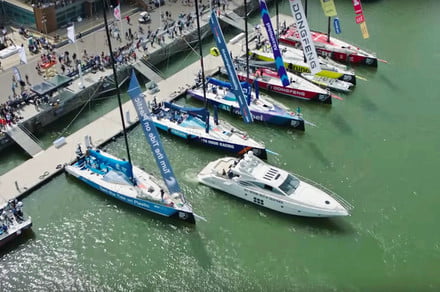We’re already working on self-parking cars, so why not take things a step further and investigate self-parking boats? Of course, the correct vernacular here isn’t “parking,” but rather “docking.” But semantics aside, Volvo — an expert on both land and water — has now designed a self-docking yacht. Because if you can afford a floating paradise, you shouldn’t have to worry about docking it on your own.
The newest solution from Volvo Penta builds upon the Volvo’s Group extensive research in the autonomous driving space. Already, the broader Volvo family has managed to produce prototype vehicles meant to be used in areas like mines and ports. So of course, developing a watercraft with similar autonomous capabilities didn’t seem like that big of a stretch. Indeed, Volvo Penta’s new self-docking solution is being called “another step forward in the development process for the group.”
Volvo recently showed off its new technology in the Gothenburg, Sweden, stopover of the Volvo Ocean race. In its live demo, Volvo showed off how a 68-foot yacht, outfitted with the autonomous technology, was able to maneuver itself into a tight space between two Volvo Ocean Race 65 racing yachts.
“Docking is one of the most challenging boat handling maneuvers – getting it wrong can be embarrassing, expensive, and precarious,” says Bjorn Ingemanson, President of Volvo Penta. “Our IPS system has already taken great strides in making docking easier, and this new self-docking feature takes that process one important stage further. Its sensors and on-board computers react in milliseconds to changing wind and sea conditions, constantly making micro adjustments in power and steering angle of the IPS drive to keep the boat on its intended course into a safe berth. If necessary, the docking process can be paused, and the system will hold the boat stationary in the water. Even in changing sea conditions it can make the sea appear to stand still.”
Of course, Volvo maintains that in order to guarantee the safety of the boat and its passengers, for now, the system is not meant to be entirely autonomous. While the technology should be able to dock a watercraft on its own, it also features surround sensors for anti-collision alerts and avoidance, and Volvo requires that a captain be at the ship’s helm during the entire docking process so that he or she can jump in if necessary.
It’s unclear when we can expect to see self-docking technology widely implemented, but for now, it’s good to know that the bright minds at Volvo are already thinking about it.
Editors’ Recommendations
- Volkswagen tests autonomous parking, aims for 2020 commercial launch
- How Nvidia is helping autonomous cars simulate their way to safety
- Why self-driving trucks will take over before self-driving cars
- Driverless pods could be used to ferry tourists around a U.K. national park
- Could fleets of self-driving cars become a public health concern?

